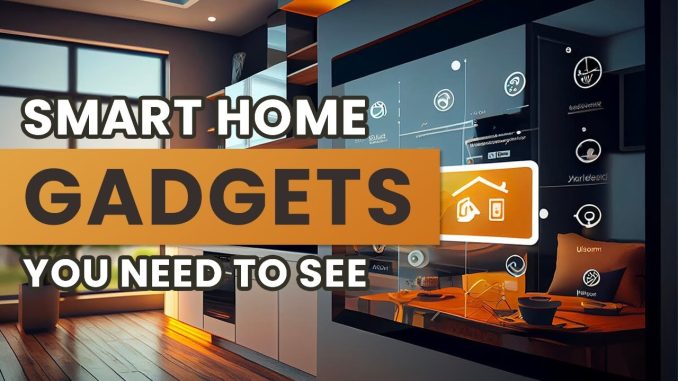
The allure of the smart home is undeniable: a living space that anticipates your needs, optimizes comfort, enhances security, and streamlines daily routines with effortless automation. Yet, stepping into this interconnected world can feel overwhelming, given the dizzying array of smart gadgets, platforms, and promises on the market. From intelligent lighting to voice-controlled assistants and sophisticated security systems, the options are seemingly endless. Choosing the right smart home gadgets isn’t about acquiring every shiny new device; it’s about a thoughtful, strategic approach that aligns technology with your specific lifestyle, budget, and long-term aspirations for your home.
The very first and most crucial step in navigating the smart home landscape is to define your primary needs and pain points. Resist the temptation to buy gadgets just because they’re “smart.” Instead, identify what aspects of your home life you want to improve. Are you looking to enhance security, reduce energy bills, simplify daily chores, improve accessibility, or merely add a layer of convenience? For instance, if security is your top concern, smart doorbells, connected cameras, and smart locks should be your starting point. If energy efficiency is paramount, intelligent thermostats, smart plugs, and energy monitoring devices would take precedence. If you’re a busy professional constantly on the go, the ability to remotely control lights and appliances might be your highest priority. By clarifying your core motivations, you create a focused roadmap for your smart home journey, preventing unnecessary purchases and ensuring genuine value.
Once your needs are clearly established, the next critical consideration is ecosystem compatibility. Smart home devices rarely operate in isolation; they are designed to work together within a larger system. The major players in this space are often tied to voice assistants: Amazon Alexa, Google Assistant, Apple HomeKit, and to a lesser extent, Samsung SmartThings. Choosing an ecosystem early on is vital, as devices within the same ecosystem are typically designed to communicate seamlessly, allowing for centralized control and more complex automations. For example, if you already use an iPhone and prefer Siri, leaning into HomeKit-compatible devices might make the most sense for you. If you frequently use a Google Nest speaker, then devices that integrate well with Google Assistant would be a logical choice. Mixing and matching too many disparate ecosystems can lead to frustrating compatibility issues and a fragmented user experience, negating the very convenience smart homes promise. While open standards like Matter are emerging to improve interoperability, committing to a primary ecosystem initially simplifies the process.
Budget considerations are, of course, a practical reality. Smart home technology spans a wide price range, from affordable smart plugs to high-end, professionally installed whole-home systems. It’s important to set a realistic budget and prioritize gadgets that offer the most bang for your buck in addressing your identified needs. Remember that a smart home can be built incrementally. You don’t need to automate everything at once. Start with a few key devices that solve your most pressing problems and expand gradually as your budget allows and your comfort with the technology grows. For instance, if you want to dip your toes into smart lighting, begin with a few smart bulbs in high-traffic areas rather than outfitting your entire home immediately.
Beyond initial purchase price, consider the ease of installation and ongoing maintenance. Are you comfortable with DIY installation, or would you prefer professional assistance? Many smart devices are designed for easy plug-and-play setup, while others, particularly advanced security systems or complex wiring for smart switches, might require specialized knowledge or a certified installer. Research user reviews and product specifications to gauge the typical installation process. Furthermore, think about long-term maintenance: will the device require frequent battery changes, software updates, or subscription fees for premium features (e.g., cloud storage for security camera footage)? Hidden costs can quickly add up, so factor these into your decision-making process.
Security and privacy features should be paramount in your selection process. Smart devices, by their very nature, collect data about your home and habits. Ensure that any device you choose comes from a reputable manufacturer with a strong track record for data security and privacy protection. Look for features like strong encryption, two-factor authentication, and clear privacy policies that explain how your data is collected, stored, and used. Be wary of generic, unbranded devices that may cut corners on security. For example, when choosing smart cameras, prioritize those with local storage options or encrypted cloud storage from trusted providers, rather than relying solely on free, unsecured cloud services. Your smart home should enhance your peace of mind, not compromise it.
Finally, consider the future scalability and longevity of your chosen devices. Technology evolves rapidly, and you want to select gadgets that are likely to receive ongoing software updates, security patches, and remain compatible with evolving smart home standards. Research the manufacturer’s commitment to product support and firmware updates. Opting for devices that support open standards like Zigbee, Z-Wave, or the upcoming Matter protocol can provide a degree of future-proofing, ensuring greater interoperability even if your chosen primary ecosystem changes or new devices emerge. This foresight can prevent your smart home from becoming a collection of isolated, outdated gadgets in a few years.
In conclusion, choosing the right smart home gadgets is a journey of thoughtful consideration, not impulsive purchasing. By clearly defining your needs, committing to a compatible ecosystem, budgeting wisely, prioritizing ease of use and long-term maintenance, ensuring robust security and privacy, and considering future scalability, you can strategically build a smart home that truly enhances your life. It’s about creating a harmonious, intelligent living space that works for you, offering genuine convenience and efficiency without the frustration of technological clutter.